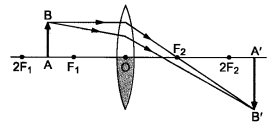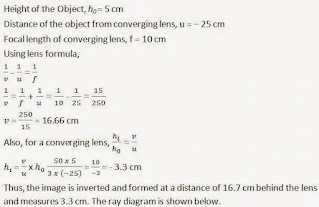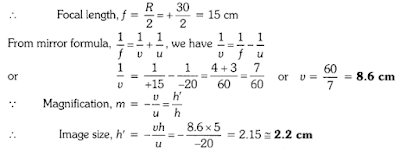Here I have provided you NCERT Solutions for Class 10 Science Chapter 10 Light - Reflection and Refraction. By going through Light Question Answers you will acquire a better command on this chapter. I hope that this will certainly help you in your studies and examinations!
Page 168
Q.1 Define the principal focus of a concave mirror.
Sol. When rays parallel and close to the principal axis of a concave mirror meet at a point , this point is called “principal focus”.
Q.2 The radius of a curvature of a spherical mirror is 20 cm. What is its focal length?
Sol. Focal length = ½ × Radius of curvature = ½ × 20 cm = 10 cm
Q.3 Name a mirror that can give an erect and enlarged imge of an object.
Sol. Concave mirror.
Q.4 Why do we prefer a convex mirror as a rear-view mirror in vehicles ?
Sol. We prefer a convex mirror as rear view mirror as it gives wider view and erect images.
Page 171
Sol. Highest optical density is of diamond , lowest optical density is of air.
Q.4 You are given kerosene, turpentine and water. In which of these does the light travel fastest ? Use the information given in Table –
Sol. Light travels faster in a medium having low optical density. Among kerosene, turpentine and water, light travels faster in water.
Q.5 The refractive index of diamond is 2.42. What is the meaning of this statement ?
Sol. It means that the speed of light in diamond is 2.42 times the speed of light in vacuum.
Page 184
Q.1 Define 1 dioptre of power of a lens.
Sol. One dioptre is the power of lens whose focal length is 1 m .
Q.2 A convex lens forms a real and inverted image of a needle at a distance of 50 cm from it. Where is the needle placed in front of the convex lens if the image is equal to the size of the object ? Also, find the power of the lens.
Sol.
Here ν = +50cm
Because the real image is of the same size as the object,
Back Exercise Questions
Q.1 Which one of the following materials cannot be used to make a lens?
(a) Water (b) Glass (c) Plastic (d) Clay
Sol.(d) Clay.
Q.2 The image formed by a concave mirror is observed to be virtual, erect and larger than the object. Where should be the position of the object ?
(a) Between the principal focus and the centre of curvature
(b) At the centre of curvature
(c) Beyond the centre of curvature
(d) Between the pole of the mirror and its principal focus.
Sol. (d) Between the pole of the mirror and its principal focus.
Q.3 Where should an object be placed in front of a convex lens to get a real image of the size of the object ?
(a) At the principal focus of the lens
(b) At twice the focal length
(c) At infinity
(d) Between the optical centre of the lens and its principal focus.
Sol. (b) At twice the focal length
Q.4 A spherical mirror and a thin spherical lens have each a focal length of –15 cm. The mirror and the lens are likely to be –
(a) Both concave
(b) Both convex
(c) the mirror is concave and the lens is convex.
(d) the mirror is convex, but the lens is concave.
Sol. (a) Both concave
Q.5 No matter how far you stand from a mirror, your image appears erect. The mirror is likely to be
(a) plane
(b) concave
(c) convex
(d) either plane or convex
Sol. (d) either plane or convex
Q.6 Which of the following lenses would you prefer to use while reading small letters found in a dictionary ?
(a) A convex lens of focal length 50 cm.
(b) A concave lens of focal length 50 cm.
(c) A convex lens of focal length 5 cm.
(d) A concave lens of focal length 5 cm.
Sol. (c) A convex lens of focal length 5 cm.
Q.7 We wish to obtain an erect image of an object, using a concave mirror of focal length 15 cm. What should be the range of distance of the object from the mirror ? What is the nature of the image ? Is the image larger or smaller than the object ? Draw a ray diagram to show the image formation in this case.
Sol. A concave mirror gives an erect image when the object is placed between the focus F and the pole P of the concave mirror, i.e., between 0 and 15 cm from the mirror. The image thus formed will be virtual, erect and larger than the object.

Q.8 Name the type of mirror used in the following situations.
(a) Headlights of car.
(b) Side/ rear-view mirror of a vehicle
(c) Solar furnace
Support your answer with reason.
Sol.
(a) Concave mirror – The bulb placed at focus throws parallel beam of light after reflection.
(b) Convex mirror – To get wider field of view and erect images.
(c) Concave mirror – To converge the rays of sun at its focus.
Q.9 One-half of a convex lens is covered with a black paper. Will this lens produce a complete image of the object ? Verify your answer experimentally. Explain your observations.
Sol. A convex lens forms complete image of an object, even if its one half is covered with black paper. It can be explained by considering following two cases.
Case I : When the upper half of the lens is covered
In this case, a ray of light coming from the object will be refracted by the lower half of the lens. These rays meet at the other side of the lens to form the image of the given object, as shown in the following figure.

Case II: When the lower half of the lens Is covered
In this case, a ray of light coming from the object is refracted by the upper half of the lens. These rays meet at the other side of the lens to form the image of the given object, as shown in the given figure:

Q.10 An object 5 cm in length is held 25 cm away from a converging lens of focal length 10 cm. Draw the ray diagram and find the position, size and the nature of the image formed.
Sol.
Q.11 A concave lens of focal length 15 cm forms an image 10 cm from the lens. How far is the object placed from the lens ? Draw the ray diagram.
Sol.
Focal length, f = -15 cm, Image distance, ν = -10 cm (as concave lens forms the image on the same side of the lens)
From the lens formula 1f=1ν−1u , we have
Q.12 An object is placed at a distance of 10 cm from a convex mirror of focal length 15 cm. Find the position and nature of the image.
Sol.
Object distance, u = -10 cm, Focal length, f = +15 cm, Image distance, ν = ?
Thus, image distance, ν = + 6 cm
Because ν is +ve, so a virtual image is formed at a distance of 6 cm behind the mirror.
Magnification,
m=−vu=−6−30=15 (i.e. < 1)The positive value of m shows that image erect and its value, which is less than 1, shows that image is smaller than the object. Thus, image is virtual, erect and diminished.
Q.13 The magnification produced by a plane mirror is +1. What does this mean ?
Sol. Magnification +1 means that an erect image is formed, having same size as object.
Q.14 An object 5.0 cm in length is placed at a distance of 20 cm in front of a convex mirror of radius of curvature 30 cm. Find the position of the image, its nature and size.
Sol.
Since object size, h = +5 cm,
object distance, u = -20 cm
and radius of curvature, R = +30 cm
A virtual, erect image of height 2.2 cm is formed behind the mirror at a distance of 8.6 cm from the mirror.
Q.15 An object of size 7.0 cm is placed at 27 cm in front of a concave mirror of focal length 18 cm. At what distance from the mirror should a screen be placed, so that a sharp focussed image can be obtained ? Find the size and the nature of the image.
Sol.
Here, object size, h = +7.0 cm,
object distance, u = -27 cm
and focal length, f = -18 cm
Image distance, ν = ?
and image size, h’ = ?
From the mirror formula, 1f=1ν−1u, we have
The screen should be placed at a distance of 54 cm on the object side of the mirror to obtain a sharp image.
The image is real, inverted and enlarged in size.
Q.16 Find the focal length of a lens of power – 2.0 D. What type of lens is this ?
Sol.
Power of lens, P= 1/f
P= -2D
f= -1/2 = -0.5 m
A concave lens has a negative focal length. Hence, it is a concave lens.
Q.17 A doctor has prescribed a corrective lens of power +1.5D. Find the focal length of the lens. Is the prescribed lens diverging or converging ?
Sol.
Power of lens, P= 1/f
P= 1.5D
f= 1/1.5 = 10/15 = 0.66 m
A convex lens has a positive focal length. Hence, it is a convex lens or a converging lens.














